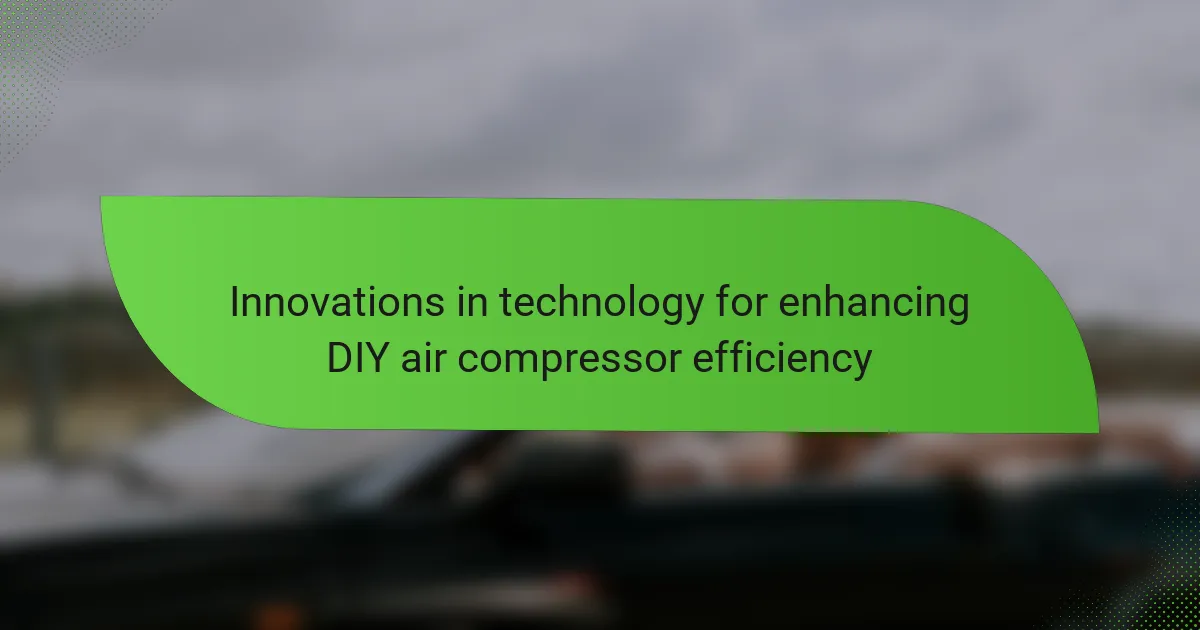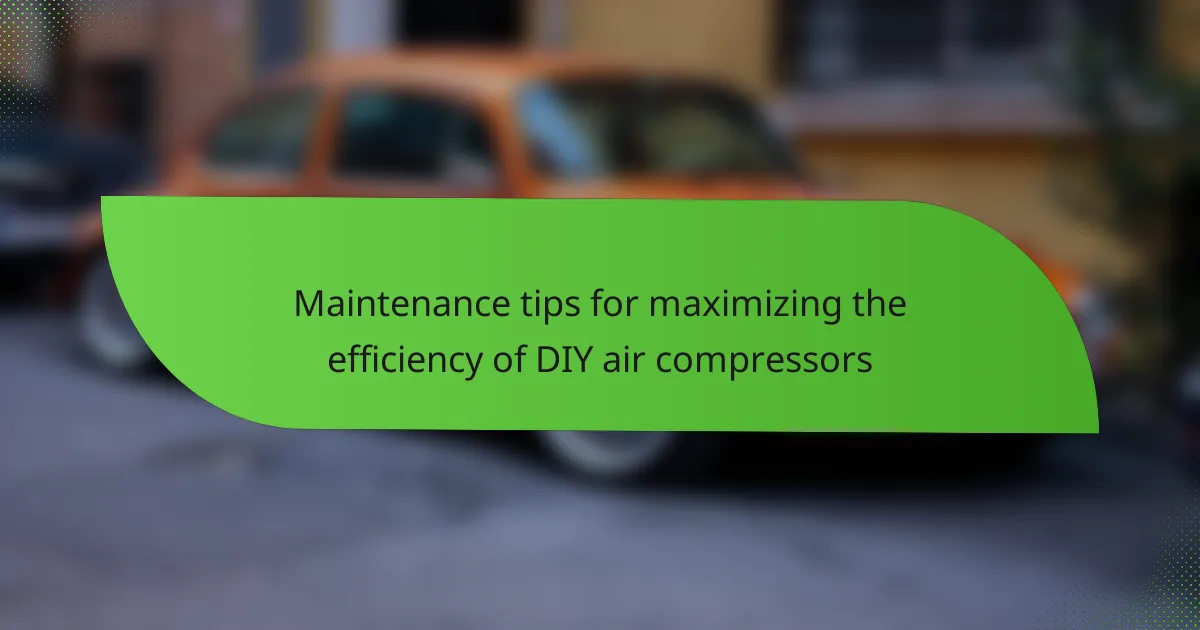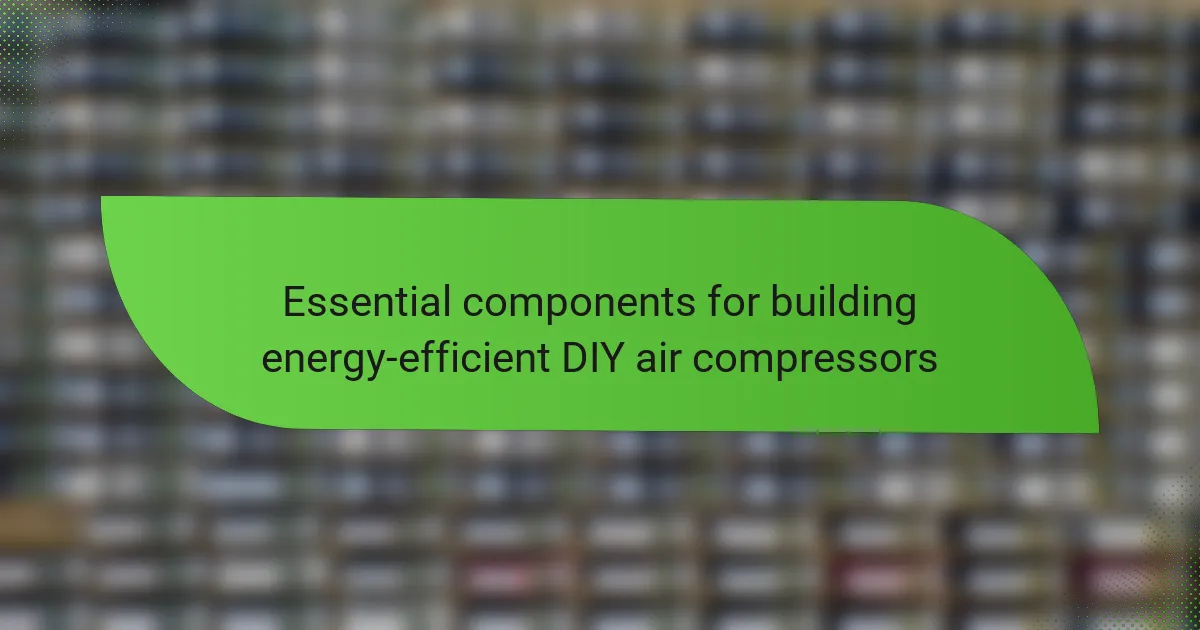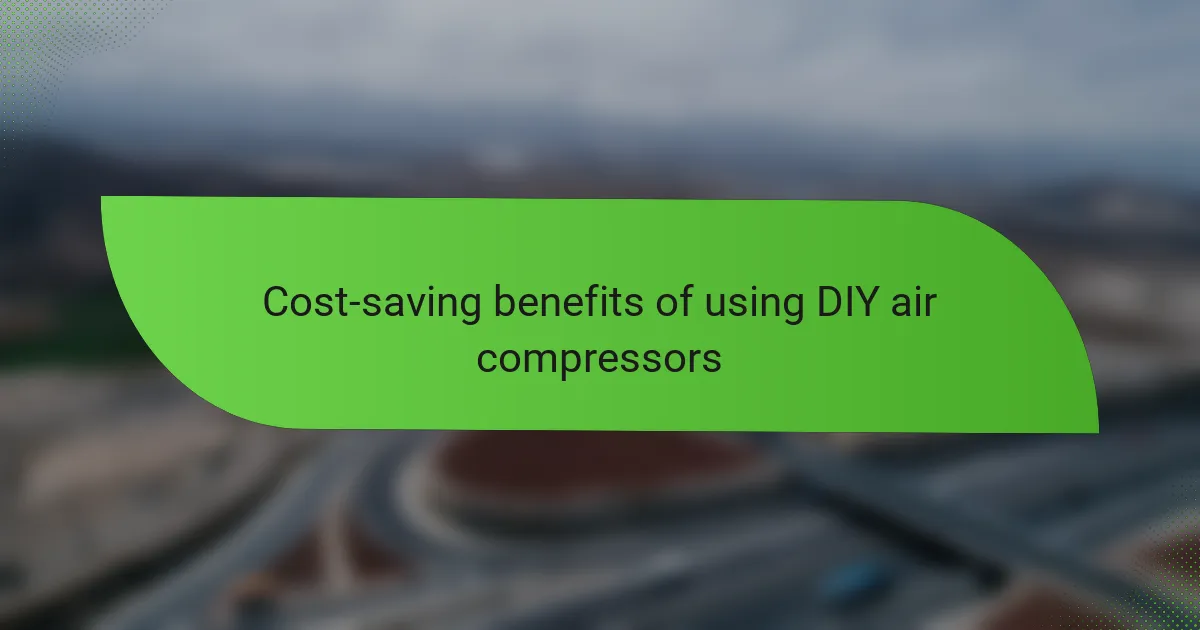DIY air compressors often face common efficiency issues that hinder their performance. Key problems include inadequate airflow due to undersized hoses or filters, pressure drops caused by leaks in hoses or fittings, and reduced efficiency from poor maintenance practices like infrequent oil changes. Additionally, using an improper power source can further compromise compressor functionality. Addressing these issues through regular checks and proper setup is essential for maintaining optimal performance and ensuring the effectiveness of DIY air compressors.
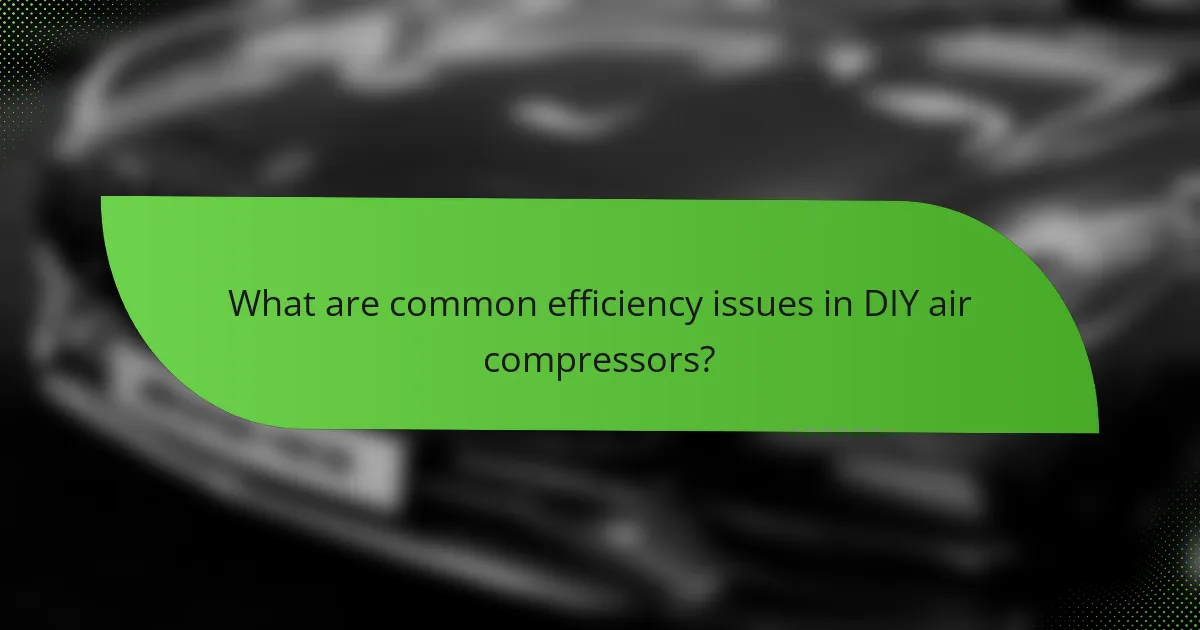
What are common efficiency issues in DIY air compressors?
Common efficiency issues in DIY air compressors include inadequate airflow, pressure drops, and poor maintenance. Inadequate airflow can result from undersized hoses or filters. Pressure drops often occur due to leaks in hoses or fittings. Poor maintenance, such as infrequent oil changes, can lead to increased friction and reduced performance. Additionally, using an improper power source can affect compressor efficiency. These issues can significantly decrease the overall effectiveness of the compressor. Regular checks and proper setup are essential for optimal performance.
How can I identify efficiency problems in my DIY air compressor?
To identify efficiency problems in your DIY air compressor, start by checking for air leaks. Inspect all hoses and connections for any signs of escaping air. Next, evaluate the pressure gauge readings. Low pressure may indicate an issue with the compressor’s ability to build pressure.
Monitor the compressor’s duty cycle. If it runs continuously without reaching the desired pressure, this can signal inefficiency. Additionally, listen for unusual noises. Sounds like grinding or excessive vibration may indicate mechanical issues.
Examine the air filter for dirt or clogs. A blocked filter restricts airflow, reducing efficiency. Lastly, assess the power consumption. If the compressor draws more electricity than usual, this may point to inefficiency. Regular maintenance can prevent many of these issues.
What signs indicate that my air compressor is underperforming?
Signs that indicate an air compressor is underperforming include reduced airflow and inconsistent pressure levels. Additionally, unusual noises such as rattling or hissing can signal problems. Overheating during operation is another common symptom. Frequent cycling on and off may also indicate inefficiency. Lastly, visible leaks around hoses or fittings can lead to performance issues. Each of these signs suggests that the compressor may require maintenance or repair to restore optimal functionality.
How does pressure loss affect the efficiency of my air compressor?
Pressure loss reduces the efficiency of an air compressor. When pressure drops, the compressor must work harder to maintain output. This increased workload leads to higher energy consumption. As a result, operational costs rise. Additionally, significant pressure loss can cause inadequate air supply for tools. This can lead to decreased performance and productivity. Studies show that even a small pressure drop can significantly impact efficiency. For example, a 10% pressure drop can reduce compressor output by up to 20%. Therefore, maintaining optimal pressure levels is crucial for efficiency.
Why is maintenance important for the efficiency of DIY air compressors?
Maintenance is crucial for the efficiency of DIY air compressors because it ensures optimal performance and longevity. Regular maintenance prevents wear and tear on components. This includes checking and replacing filters, lubricating moving parts, and inspecting hoses for leaks. Neglecting maintenance can lead to reduced airflow and increased energy consumption. According to the U.S. Department of Energy, poorly maintained compressors can use up to 30% more energy. Additionally, regular maintenance can identify issues before they escalate into costly repairs. Keeping air compressors well-maintained enhances their reliability and efficiency in various applications.
What routine maintenance tasks should I perform on my air compressor?
Perform routine maintenance on your air compressor to ensure optimal performance. Regularly check and change the oil as specified in the manufacturer’s manual. Inspect and clean the air filter to prevent dust and debris buildup. Drain the moisture from the tank to avoid rust and corrosion. Tighten any loose connections to maintain efficient airflow. Test the pressure relief valve to ensure it functions correctly. Inspect hoses and fittings for leaks or wear. Regular maintenance can extend the life of the compressor and enhance efficiency.
How does improper maintenance lead to efficiency issues?
Improper maintenance leads to efficiency issues in DIY air compressors by causing wear and tear on components. Regular maintenance ensures that parts function optimally. Without it, dirt and debris can accumulate, obstructing airflow. This obstruction reduces the compressor’s ability to generate pressure effectively. Furthermore, worn seals can lead to air leaks, which diminish overall efficiency. A study by the U.S. Department of Energy indicates that poorly maintained compressors can lose up to 30% of their efficiency. Additionally, inadequate lubrication can result in increased friction, causing the motor to work harder and consume more energy. These factors combined significantly hinder the performance of air compressors.
What role do components play in the efficiency of DIY air compressors?
Components play a crucial role in the efficiency of DIY air compressors. Each component, such as the motor, pump, and tank, directly affects performance. The motor determines the power output and speed, influencing how quickly air is compressed. The pump’s design impacts the compression ratio and airflow rate. A well-designed pump can enhance efficiency by minimizing energy loss. The tank size affects the storage capacity and pressure stability. Larger tanks can provide more consistent airflow for tools. Additionally, filters and regulators help maintain air quality and pressure, improving overall efficiency. Properly selected and maintained components can lead to a significant increase in operational efficiency and longevity of the compressor.
How can worn-out parts impact the performance of my air compressor?
Worn-out parts can significantly reduce the performance of your air compressor. They can lead to decreased efficiency, increased energy consumption, and diminished air pressure output. For example, worn piston rings may cause air leaks, resulting in a drop in pressure. This can make the compressor work harder, consuming more electricity. Additionally, degraded valves can affect the airflow, causing erratic operation. Research shows that maintaining parts in good condition can improve compressor efficiency by up to 30%. Regular inspections and timely replacements are essential for optimal performance.
What are the best practices for selecting compressor components to enhance efficiency?
Select high-quality components for compressors to enhance efficiency. Quality components reduce energy loss and improve performance. Choose appropriate size and capacity to match the application requirements. Oversized components can lead to inefficiencies and increased energy consumption. Use energy-efficient motors to decrease operational costs. Energy Star-rated motors can save up to 30% in energy use. Opt for variable speed drives to adjust compressor speed based on demand. This flexibility minimizes energy waste. Implement proper filtration systems to prevent dirt and debris from entering the compressor. Clean air intake improves efficiency and extends component lifespan. Regularly maintain and inspect components to ensure optimal operation. Scheduled maintenance can improve efficiency by up to 20%.
How can I troubleshoot specific efficiency issues in my DIY air compressor?
To troubleshoot specific efficiency issues in your DIY air compressor, first check for air leaks in the system. Use soapy water to identify bubbles forming at connections and seals. Next, inspect the air filter for clogs. A dirty filter restricts airflow, reducing efficiency. Clean or replace the filter as needed.
Ensure the compressor is set to the correct pressure levels. Operating outside recommended pressure can lead to inefficiencies. Verify that the motor is functioning properly. A malfunctioning motor can cause inadequate compression.
Additionally, check the compressor’s oil level if it is oil-lubricated. Low oil levels can lead to increased friction and reduced efficiency. Lastly, inspect the hoses for kinks or blockages. Smooth airflow is crucial for optimal performance.
What steps should I take if my air compressor is not reaching the desired pressure?
Check the air compressor’s settings and ensure they are correctly configured for the desired pressure. Inspect the pressure gauge for accuracy and recalibrate if necessary. Examine the air intake filter for blockages; a dirty filter can restrict airflow. Inspect the hoses and connections for leaks, as air loss can prevent reaching the desired pressure. Ensure that the compressor tank is not full, as this can limit pressure buildup. If the compressor is still not reaching the desired pressure, check the motor and pump for any mechanical issues. Regular maintenance, such as lubricating moving parts, can also improve performance.
How can I fix issues related to air leaks in my compressor system?
To fix issues related to air leaks in your compressor system, start by inspecting all connection points and hoses. Look for visible signs of wear, cracks, or loose fittings. Tighten any loose connections to ensure a secure seal. Apply a soapy water solution to suspected areas; bubbles will form at leak sites. Replace damaged hoses or fittings immediately to prevent further air loss. Regular maintenance checks can help identify potential leaks early. According to a study by the Compressed Air and Gas Institute, addressing air leaks can improve compressor efficiency by up to 30%.
What are the common mistakes to avoid when troubleshooting efficiency issues?
Common mistakes to avoid when troubleshooting efficiency issues include skipping systematic checks. Failing to follow a structured approach can lead to overlooked problems. Ignoring manufacturer guidelines often results in misdiagnosis. Not checking for leaks can waste energy and reduce performance. Overlooking regular maintenance tasks can exacerbate efficiency issues. Relying solely on visual inspections may miss hidden faults. Neglecting to document changes makes it hard to track progress. Lastly, assuming the issue is electrical without checking mechanical components can lead to wasted effort.
How can I ensure I’m not overlooking critical components during troubleshooting?
To ensure you’re not overlooking critical components during troubleshooting, create a comprehensive checklist. This checklist should include all essential parts of the air compressor, such as the motor, pressure switch, and air filter. Systematically go through each component on the list. Verify that each part is functioning correctly and is free from damage. Utilize diagnostic tools like multimeters to test electrical components. Refer to the manufacturer’s manual for specific troubleshooting guidelines. Document any issues found for future reference. Following these steps can significantly reduce the chances of missing critical components.
What are the best practices for documenting troubleshooting efforts?
Best practices for documenting troubleshooting efforts include maintaining a clear and organized record of each issue encountered. Document the problem description, symptoms, and any error codes. Record the steps taken to diagnose the issue. Include any tests performed and their results. Note the time taken for each troubleshooting step. Use consistent terminology for clarity. Ensure that documentation is accessible for future reference. This practice supports continuous improvement and knowledge sharing. Accurate records can help identify recurring issues and streamline future troubleshooting efforts.
What tips can enhance the efficiency of my DIY air compressor?
To enhance the efficiency of your DIY air compressor, ensure proper maintenance and optimal setup. Regularly check and replace air filters to avoid blockages. Clean the compressor’s intake vents to improve airflow. Use the correct gauge wire for electrical connections to minimize energy loss. Ensure all fittings and hoses are airtight to prevent leaks. Install a pressure regulator to maintain consistent pressure levels. Keep the compressor in a well-ventilated area to prevent overheating. These practices can significantly improve performance and longevity.
The main entity of the article is DIY air compressors, focusing on troubleshooting common efficiency issues. Key topics include identifying efficiency problems such as inadequate airflow, pressure drops, and maintenance neglect. The article outlines methods for detecting underperformance signs, the impact of pressure loss, and the importance of regular maintenance. Additionally, it emphasizes the role of components in efficiency and provides best practices for selecting and maintaining these parts to enhance overall compressor performance. Tips for troubleshooting specific issues and avoiding common mistakes are also discussed to optimize the functionality of DIY air compressors.
